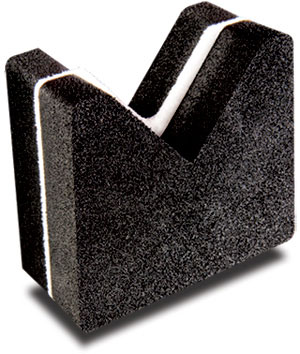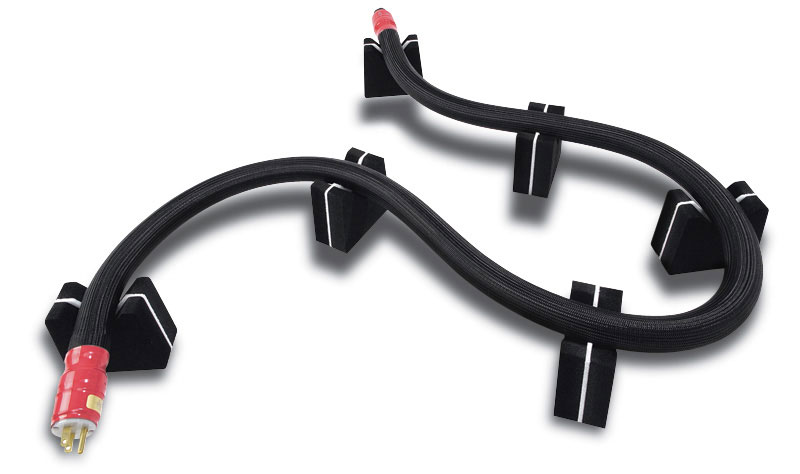 February 2009
Shunyata Research Dark Field Cable
Elevators
by Ken Choi
| 
|
Review Summary
| Sound |
"Under the speaker
cables, however, there was an appreciable improvement in resolution and a darker background
not unlike the effect of using the Hydra Model-8, but it was admittedly on a smaller scale.
Sonic images were given more body and definition. On a couple of SACDs I felt that there was
improvement in high-frequency resolution in particular." |
|
| Features |
"The Dark Field
cable elevators are constructed from two pieces of electrically conductive foam and are said
to equalize the charge differential between the floor material and the field surrounding the
signal path of the cable. A thin central plate of stiffer foam lends to the mechanical
integrity of the product and also helps with vibration control. As the two types of foam have
different resonant frequencies, vibrations within the elevator itself are also
eliminated." |
|
| Use |
"Try as I might, I
could detect no consistent difference in the sound of my system when they were used with the
interconnects or power cords alone." |
|
| Value |
"I would urge
anyone who has gone the whatever's-around-the-house route -- using inverted CD cases, bundled
chopsticks, or Styrofoam cups -- to elevate their cables to give these a try. Not only will
they look a lot better, I expect that they will perform better too." |
|
|
|
A few years ago, when asked what I did over the
weekend, I told friends that I had spent the better part of it trying different power
cords with my CD player. Incredulous stares were quickly followed by hoots of derision. I
timidly tried to defend my avocation, but I did not go so far as to say that I enjoyed
auditioning the cords, which I did. Truth be told, I might not have enjoyed it as much had
I known that I would have to report my findings on SoundStage!, but what dawned on
me then was the core of the audiophile exercise. We simply delight, and indeed at times
marvel, at hearing the difference that a change in our system makes to its sound.
Of course, changing the listening environment or
speakers will affect the sound most profoundly. Then follow the sources and amplification.
But at some point in time most of us will either be generally satisfied with our
system’s performance or encounter fiscal restraints that preclude major upgrades.
What then to do to sate our audiophile jones? Well, we could modify our existing
equipment, but this implies irreversible changes that may not be entirely positive or
particularly inexpensive.
Tweaks are the way to go when audio ennui sets
in. They are reversible interventions you make to your system in an attempt to improve its
sound and performance. They can range from simple DIY procedures such as realigning your
cartridge to the acquisition of elaborate and expensive commercial products, all designed
to somehow allow the delicate electrical signals to pass from source to transducer with
ever greater fidelity. While tweaks are generally based on scientific principles, many, if
not most of us, are not physicists or engineers but rather music lovers. And therein lies
a corollary to the audiophile exercise. The use of tweaks enables us right-hemisphere
types to express our latent and poorly developed left-hemisphere tendencies.
Unfortunately, it makes us vulnerable to pseudo-science as well.
While looking at pictures of some of the more
elaborate audio systems, I noted that many of collections incorporated ceramic elevators
to lift speaker cables off the floor. These, I found out, are not terribly cheap and so it
was that I found myself wandering through a restaurant-supply store one day when I came
across some porcelain sugar-packet holders that seemed like they were made for lifting
cables. Since they were less than a dollar each, I depleted the vendor’s supply and
felt that, at worse, the purchase would afford me a few hours of harmless entertainment
and, at best, I would be transported to sonic nirvana. As it turned out, I wasted about
$20 and several hours of time.
Not completely disheartened by my earlier
experience, when I learned that Shunyata Research had developed a set of cable elevators
($295 USD per set of 12), I set into motion a request for some review samples. This is a
company I have come to respect, principally for the Hydra Model-8 power conditioner, which
has been the single most beneficial tweak (although some may consider it a component) I
have made to my system over the years. I also have experience with some of Shunyata's
power cords, and they never did less than advertised, although, frankly, personal tastes
and system matching precluded their universal use in my system. I should qualify that had
I the opportunity and time to experiment with all Shunyata's myriad of cords, they
well might be in universal use.
| Associated Equipment Loudspeakers – Wilson Audio WATT/Puppy
7.
Power amplifiers – Audio
Research 100.2 stereo amp, Nagra VPA mono amps.
Preamplifier – Audion Premier
Quattro.
Digital – EMM Labs CDSD transport and
DCC2 DAC.
Analog – Oracle Delphi V turntable,
SME V tonearm, Zyx Universe S cartridge.
Interconnects – Purist Audio Design
Venustas.
Speaker cables – Purist Audio Design
Venustas.
Power conditioner – Shunyata Research
Hydra Model-8.
Power cords – Shunyata Research
Anaconda Helix Alpha, Essential Sound Products The Essence Reference, homemade extension
cord made with Cardas Crosslink. |
|
|
The premise for elevating cables off the floor
relates to mechanical isolation from floor-borne vibrations and electrical isolation from
static imbalances that may be present on the flooring surface. Certainly both forms of
interference can wreak havoc on other of our audio components, so why not cables? However,
one might expect the type of floor, its covering and the construction of the cable all to
play a role in how effective or necessary these cable lifters are.
Shunyata Research has a slightly different take
on this. The company posits that lifting cables off the floor with commonly used
electrically insulating materials such as ceramics will, over time, create the buildup of
a large static differential between the cable and the floor, which, in fact, would be
deleterious to the audio signal. Shunyata proposes a "static-field-unification"
principle. The Dark Field cable elevators are constructed from two pieces of electrically
conductive foam and are said to equalize the charge differential between the floor
material and the field surrounding the signal path of the cable. A thin central plate of
stiffer foam lends to the mechanical integrity of the product and also helps with
vibration control. As the two types of foam have different resonant frequencies,
vibrations within the elevator itself are also eliminated.
Not being particularly comfortable with these
explanations myself, I referred the Shunyata's online information over to my golfing buddy
Ed. Now, Ed is a Ph.D engineer with a special interest in matters metallurgical, and he
takes his work much more seriously than his golf game. He pronounced the science sound,
but he admitted that he’d have no clue as to how this would affect the way a stereo
would sound. That, I suppose, is up to me to describe.
I am fortunate to have a dedicated listening room
in the basement. It has a concrete floor that is covered by a Berber carpet made of
synthetic materials. I have long been a proponent of having my sources and preamplication
removed from between the speakers. As such, I use six-meter interconnects between the
preamp and amplifier. These and my speaker cables are from Purist Audio Designs' Venustas
series. My system is all powered through one Shunyata Hydra Model-8 that is fed from a
dedicated circuit. My amps are far removed, their ESP The Essence power cords connected to
the Hydra by an eight-meter extension cord constructed from bulk Cardas Crosslink speaker
cable.

I tried the Dark Field elevators individually
under the speaker cables, the long interconnects and the amplifier power cords. I had two
sets of 12 elevators at my disposal, so I was able to try them under all of these cables
simultaneously. Unfortunately, circuitous routing prevented me from using them on my
extension power cord. My methodology involved using the elevators for three or four cuts
of music, removing them, listening to the same music, and then reinserting them for a
final listen.
Try as I might, I could detect no consistent
difference in the sound of my system when they were used with the interconnects or power
cords alone. Under the speaker cables, however, there was an appreciable improvement in
resolution and a darker background not unlike the effect of using the Hydra Model-8, but
it was admittedly on a smaller scale. Sonic images were given more body and definition. On
a couple of SACDs I felt that there was improvement in high-frequency resolution in
particular.
The magnitude of these changes was difficult to
quantify and probably will vary greatly from system to system and listener to listener. In
my system, the effect from using the Dark Field elevators was significantly more
pronounced than that from the vibration-control devices I use under my preamp, for
instance. The effect was similar in scale to the benefits I derive from using
Herbie’s Audio Ultrasonic tube dampers on the eight tubes that protrude from the
preamp.
Unlike the sugar-packet holders I tried before,
Shunyata’s Dark Field elevators not only changed but clearly enhanced my
system’s sound. I would urge anyone who has gone the whatever's-around-the-house
route -- using inverted CD cases, bundled chopsticks, or Styrofoam cups -- to elevate
their cables to give these a try. Not only will they look a lot better, I expect that they
will perform better too. For those skeptical of the benefits of cable elevators, I
particularly recommend an audition of these. Regardless of the scientific rationale,
products like the Dark Field elevators and the effect they have on the sound keep the
audiophile hobby fun and interesting.
...Ken Choi
kenc@soundstage.com
Shunyata Research Dark Field Cable
Elevators
Prices: $295 USD per set of 12.
Warranty: Five years parts and labor.Shunyata Research
26273 Twelve Trees Lane, Suite D
Poulsbo, WA 98370
Phone: (608) 850-6752
E-mail: info@shunyata.com
Website: www.shunyata.com |
|

